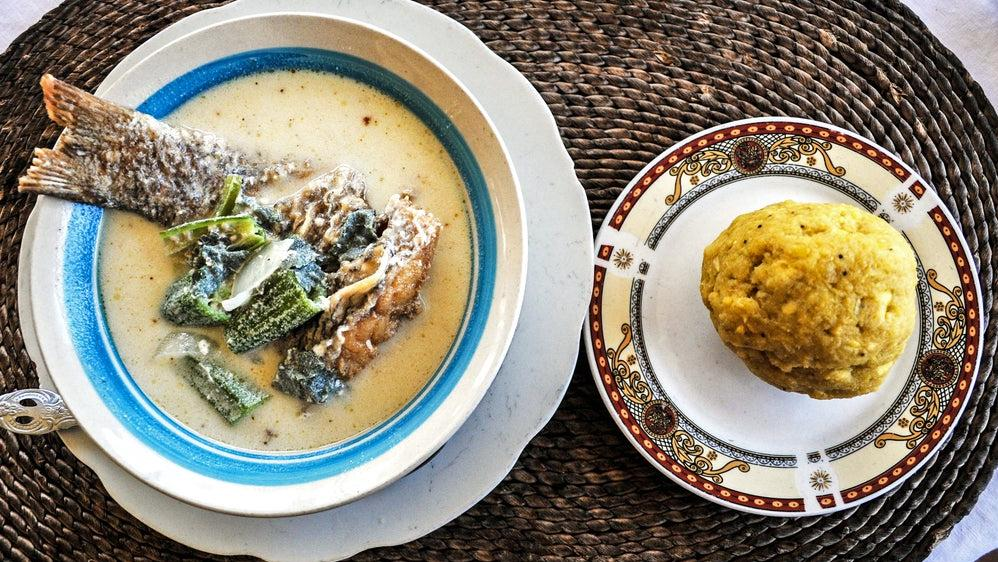Hudut's Flavors Are Centuries In The Making
This traditional Garifuna dish deliciously captures the diversity of Belize.
When I landed on Belize's Ambergris Caye, which overlooks the Belize Barrier Reef in all its shimmering glory, the lyrics to Madonna's classic tune "La Isla Bonita" ran through my head. It was this island, and its capital of San Pedro, that inspired the song. I immediately understood why.
Candy-colored wooden buildings lined the main square, locals whizzed by on bikes and golf carts (no cars allowed, except for taxis and delivery trucks), and manatees splashed in nearby lagoons. But I traveled to Belize to look beyond the dazzling landscape; I wanted to experience the complex, multidimensional culture, in which food (unsurprisingly) plays a starring role.
The traditional dishes of Belize
The first inkling I had that food was of the utmost importance in Belize was the long list of dishes my Belizean friends in Chicago insisted that I try. Chicago has a sizable Belizean community, so prior to my trip I was already well acquainted with panades (deep-fried masa crescents stuffed with beans or fish) and garnaches (fried corn tortillas topped with refried beans and chopped cabbage and tomatoes), as well as popular meals composed of rice and beans and stewed chicken. But my friends also named foods I'd never heard of, things like rompopo, dukunu, and serre. So I headed off to the sandy streets of San Pedro to take in these culinary traditions for myself.
Since it was February, I wasn't expecting to enjoy any rompopo, the creamy rum drink typically reserved for holidays—so I was thrilled when a waiter snagged a homemade bottle and served me two glasses of the sweet and limb-loosening cocktail. It turns out that you can find the drink all year round, if you ask for it. I strolled into the wood-carved interior of Saul's Cigar & Coffee House and found shelves filled with flavors like coconut, coffee, and mocha; although they were labeled as rum creams, it tasted exactly like the rompopo I had sipped the night before. Belizeans don't let the calendar stop them from enjoying a festive drink.
On a sunny corner of downtown San Pedro, I managed to locate a prime Belizean specialty: fry jacks, which are so beloved they're often considered the national dish. I bit into the warm, salty triangle of fried dough served with spicy chicken and tasted why fry jacks are essential to Belizean meals. I also tried a sweet version with powdered sugar and bananas, and both versions of this flaky goodness made me forget about any other type of bread.
The Caribbean influence on Belize's Central American foods was most evident in the dukunu I found a vendor selling in front of a lime-green storefront. I had heard about dukunu not only from my friends' list of recommendations but also when I was traveling in Antigua, where it was described as a sweet potato dessert. Here, however, the vendor presented me with a corn husk that looked just like a tamale. I unwrapped the warm husk and the scent of coconut and sugar wafted out. The sweet treat is made from roasted corn kernels blended with coconut milk, and it tasted like a rich, tropical corn pudding.
Belize’s Garifuna cuisine
I thought I had gathered a deliciously comprehensive understanding of Belizean food until I visited the popular Black & White Garifuna restaurant. The striped black, white, and yellow Garifuna flag waved over the restaurant's covered outdoor seating, an area accented with plants and traditional tapestries and wood carvings.
The Garifuna are Afro-Indigenous people who originated on the Caribbean island of St. Vincent and were exiled to Honduras in the 18th century, arriving in Southern Belize in in the decades that followed. Garifuna culture, integral to Belizean life, is showcased in the traditional dishes that draw influences from Central America, Africa, and the Caribbean.
I ordered the signature Garifuna dish, hudut. When the steaming bowl of fish, cassava, okra, coconut milk, and pounded plantains garnished with a habanero pepper arrived, I was captivated by the sweet and spicy aroma. I slurped the savory stew and barely stopped to add the rice and cassava bread sides. It was flavorful and filling, with so many ingredients and blending together in perfect harmony.
Julia, the owner, explained that the dish, with its many cultural influences, represents the journey taken by the Garinagu (plural). Although hudut is a beloved Garifuna dish, it's actually sometimes called serre, referencing the fish and coconut broth. This, I realized, was the dish that my friends were most excited that I try. I'm so glad I did—it was the creamy bite that brought me closest to understanding the diversity of Belize, and just how good those influences can taste.
